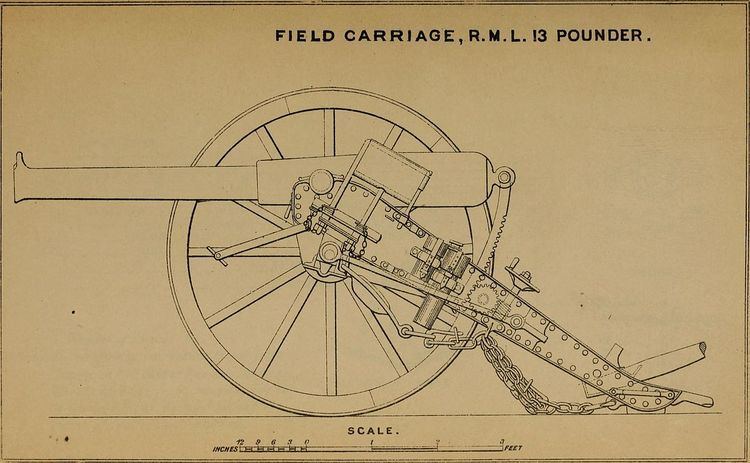Type Field gun In service 1879 - 1902 Designer Woolwich Arsenal | Place of origin United Kingdom Used by British Empire Manufacturer Woolwich Arsenal | |
 | ||
The RML 13 pounder 8 cwt gun was a British Rifled, Muzzle Loading (RML) field artillery gun manufactured in England in the 19th century, which fired a projectile weighing approximately 13 pounds (5.9 kg). "8 cwt" refers to the weight of the gun.
Contents
Design and manufacture
The 13 pounder was the last Rifled Muzzle Loading field gun to be produced, with production starting in 1879. Unlike the 9 and 16 Pounder RML guns, the 13 pounder had a much greater muzzle length. They could be finished as muzzle loaders or breech loaders, however they were all ordered to be finished as muzzle loaders. Their construction consisted of an 'A' tube of toughened steel, over which was shrunk a 'B' tube of wrought iron. The gun was rifled using a polygroove system, comprising 10 grooves on the Maitland system.
The gun was fitted with a set of sights on the centre of the barrel. This enabled the gun to be sighted for indirect, or direct fire. A flat surface was machined on top of the barrel for a clinometer to be used, enabling the gun to be levelled, or to provide an alternate method of indirect sighting.
Operation
The 13 pounder was normally deployed in batteries of six or four guns. Each gun was pulled by a team of six horses. It had a crew of nine men – five crew who could be mounted on seats on the limber and gun, three drivers and a gun commander (number one) mounted separately.
In addition to each gun, a limbered ammunition trailer was also horse drawn. When deployed as Field Artillery it was designed to move at the same speed as infantry, or when deployed as Horse Artillery being used where greater speed was required.
Guns were fired using a silk bag containing a black powder propellant. They used three types of ammunition – Common shell (for use against buildings or fortifications), shrapnel shell (for use any Infantry or Cavalry) and case shot (for close range use against 'soft' targets. Ignition was through a copper lined vent at the breech end of the gun. A copper friction tube would be inserted and a lanyard attached. When the lanyard was pulled the tube would ignite, firing the gun. A number of different fuzes could be used enabling shells to either burst at a pre-determined time (and range), or on impact. A typical rate of fire was one round per minute.
Service history
The 13 pounder saw action in the Anglo-Egyptian War of 1882, where four Batteries were deployed, two with the Royal Horse Artillery and two as Field Artillery. It remained in front-line service with the Royal Artillery until the late 1880s when replaced by the 15 pounder Breech-Loading gun.
Some were re-issued to the 3rd Middlesex Volunteer Artillery as Batteries of Position from 1889 and some remained in use until around 1902, when they were succeeded by more modern breech loading guns.
A surviving example with carriage is displayed at Fort Rodd Hill, British Columbia.
Another 2 surviving examples are on the Armed Forces of Malta's Headquarters barracks parade ground. Formerly on display above the main entrance to the Royal Army Ordnance Corps' HQ in Floriana Malta, they were then taken on charge by the AFM Luqa officers' mess when the ROAC shut up shop in Malta as part of the forces drawdown. Placed on display in Luqa barracks, they slowly deteriorated and were removed in 1994. After more than a decade languishing in the officers' mess kitchen yard, the two were restored by Air Defence Battery personnel in 2005 with the assistance of the curator of "Firepower", the Royal Artillery museum, who provided plans and manuals. When the restoration was finished, the two guns were placed on the Luqa barracks parade ground where they remain to this day.
The last known survivor, and the only one located in a building is located at the museum of 5th (BC) Regiment, Royal Canadian Artillery.
